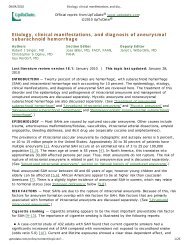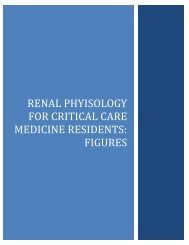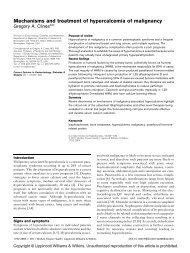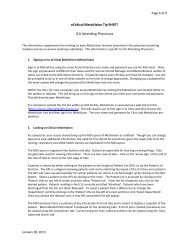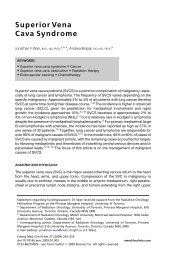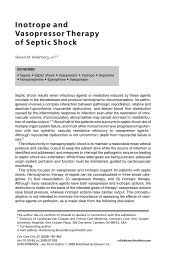Capnographic Waveforms in the Mechanically Ventilated Patient
Capnographic Waveforms in the Mechanically Ventilated Patient
Capnographic Waveforms in the Mechanically Ventilated Patient
You also want an ePaper? Increase the reach of your titles
YUMPU automatically turns print PDFs into web optimized ePapers that Google loves.
REFERENCE<br />
1. Murray IP, Modell JH, Gallagher TJ, Banner<br />
MJ. Titration of PEEP by <strong>the</strong> arterial<br />
m<strong>in</strong>us end-tidal CO 2 gradient. Chest 1984;<br />
85(1):100–104.<br />
Thompson: I th<strong>in</strong>k we would be more<br />
apt to use V D/V T [<strong>the</strong> ratio of dead space<br />
to tidal volume] now with more modern<br />
equipment. But, yes, absolutely. I was<br />
brought up on <strong>the</strong> gradient that it’s all<br />
dead space ventilation. Shunt has very<br />
little to do with that gradient, so you are<br />
<strong>in</strong>creas<strong>in</strong>g alveolar dead space when you<br />
widen <strong>the</strong> gradient. I agree.<br />
Hess: On that subject I would refer<br />
to Lluis Blanch’s 1987 paper. 1<br />
REFERENCE<br />
1. Blanch L, Fernandez R, Benito S, Mancebo<br />
J, Net A. Effect of PEEP on <strong>the</strong> arte-<br />
CAPNOGRAPHIC WAVEFORMS IN THE MECHANICALLY VENTILATED PATIENT<br />
rial m<strong>in</strong>us end-tidal carbon dioxide gradient.<br />
Chest 1987;92(3):451–454.<br />
Blanch: Yes. We studied <strong>the</strong> effect<br />
of PEEP on <strong>the</strong> arterial m<strong>in</strong>us endtidal<br />
CO 2 gradient <strong>in</strong> patients with<br />
acute lung <strong>in</strong>jury. At similar cardiac<br />
output, <strong>the</strong> gradient decreased with<br />
PEEP, equal to <strong>the</strong> lower <strong>in</strong>flection<br />
po<strong>in</strong>t of <strong>the</strong> P-V curve, and with patients<br />
who did not have a lower <strong>in</strong>flection<br />
po<strong>in</strong>t we applied a random<br />
PEEP level, and <strong>the</strong> behavior of <strong>the</strong><br />
gradient was unpredictable and not<br />
correlated with changes <strong>in</strong> oxygenation.<br />
The <strong>in</strong>terpretation was that<br />
PEEP <strong>in</strong>duced alveolar recruitment,<br />
decreased alveolar dead space, and <strong>the</strong><br />
gradient narrowed, whereas <strong>the</strong> contrary<br />
occurred when PEEP <strong>in</strong>duced<br />
overdistension and both alveolar dead<br />
space and <strong>the</strong> gradient <strong>in</strong>creased.<br />
Therefore, variations of <strong>the</strong> gradient<br />
at similar hemodynamic status might<br />
help cl<strong>in</strong>icians understand <strong>the</strong> physiologic<br />
effects of PEEP.<br />
Bigatello: I th<strong>in</strong>k this br<strong>in</strong>gs up <strong>the</strong><br />
utility of look<strong>in</strong>g at CO 2 elim<strong>in</strong>ation<br />
as an <strong>in</strong>dex of alveolar recruitment,<br />
which Gatt<strong>in</strong>oni et al reported on. 1 If<br />
we are recruit<strong>in</strong>g <strong>the</strong> lung and not overdistend<strong>in</strong>g,<br />
but truly recruit<strong>in</strong>g new<br />
units, we should ventilate better so <strong>the</strong><br />
P aCO2 will decrease.<br />
REFERENCE<br />
1. Gatt<strong>in</strong>oni L, Vagg<strong>in</strong>elli F, Carlesso E, Taccone<br />
P, Conte V, Chiumello D, et al; Prone-<br />
Sup<strong>in</strong>e Study Group. Decrease <strong>in</strong> P aCO2 with<br />
prone position is predictive of improved<br />
outcome <strong>in</strong> acute respiratory distress syndrome.<br />
Crit Care Med 2003; 31(12):2727–<br />
2733.<br />
RESPIRATORY CARE • JANUARY 2005 VOL 50 NO 1 109



